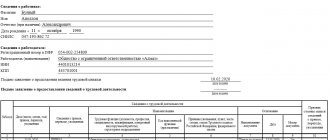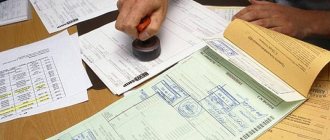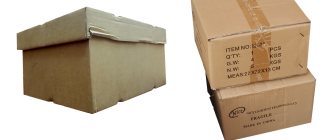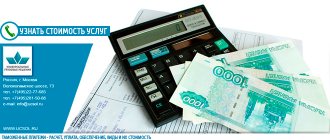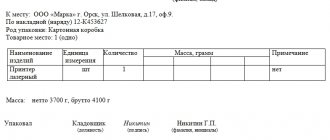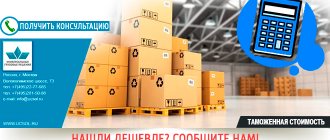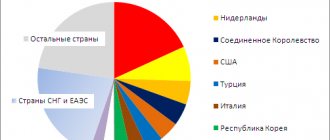Please note: the abbreviation CCD, like the very concept of “cargo customs declaration”, is outdated. Now there is a “declaration of goods” - TD, however, both of these terms are still often used.
According to established state regulations, certain documents must be prepared for goods imported and exported across the state border of the Russian Federation through the territory of the Customs Union - commodity and cargo customs declarations. At the same time, the obligatory procedure is the payment of customs duties, taxes, fees and other payments, which are formed on the basis of the DTS (declaration of customs value), which is an integral part of the customs declaration; without it, it will not have legal force.
Customs services carefully check not only the cargo itself, but also commodity and cargo customs declarations
To fill it out correctly, you need to know what the customs value in the customs declaration consists of, what the statistical value of the goods in the cargo customs declaration is. And also understand how customs value is calculated, how to fill out the customs declaration in accordance with established norms and rules. After all, a successfully accepted and registered cargo customs declaration is a document confirming the legality of transporting goods across the state border.
The company’s specialists know exactly how to fill out a cargo customs declaration, all the requirements for its registration, the procedure for registration and submission, and will calculate the total customs value in the customs declaration quickly and without errors.
The concept of customs value in the customs declaration
These are cost characteristics that are determined for the calculation of payments; the declarant determines and calculates the customs value of the goods in the customs declaration. But at the same time, all information and data on the basis of which the vehicle was calculated must be truthful, transparent and supported by documents, since a representative of the customs authority will check all calculations.
And if a discrepancy is discovered, prices are overestimated or underestimated, concealment of any facts during calculations, the declaration of customs value, and with it the cargo customs declaration, are not accepted, they will be required, at a minimum, to be redone. Customs value is the value of the cargo, which is calculated based on international treaties of the states that are members of the Customs Union.
The customs value is calculated by the declarant
Its calculation is carried out by the declarant or a customs broker; specialists can act as the first. The documents attached to the customs declaration must reflect all the information on the basis of which the calculations were made; control over the declared amounts is carried out by customs officers.
The statistical value of goods in the customs declaration is the value that is assigned to goods according to established rules in the country of statistical accounting. It is included as one of the items in the customs declaration; a special column is allocated for it in the document. Information about the customs value and the method of its calculation are described in the DTS - a Special document that reflects the value of the goods transported across the state border.
At its core, the declaration of customs value, which is a mandatory appendix to the customs declaration, is a settlement form that reflects the costs of purchasing products and transportation costs for transporting trade and material assets through customs. That is, the customs value of the goods is determined. The statistical value of goods in the cargo customs declaration indicates the value of the goods, taking into account other expenses, for example, transport and others until they were delivered to the customs point to cross the border to the destination country.
In order to correctly fill out documents and pass customs control without any problems, you need to know the procedure for preparing DTS declarations, the structure, how the total customs value is calculated in the customs declaration and what it consists of. All these tasks will be undertaken by specialists: we will perform the full range of necessary customs services and help you quickly pass customs control.
“Statistical form for recording the movement of goods” (customs): due date 2021
The document must be submitted to the Customs Service within a period not exceeding 8 working days from the end of the month of shipment of the goods. The cutoff dates for transactions completed in 2021 are presented in the table:
| Month of shipment of goods in 2021 | Deadline |
| January | 12th of February |
| February | March 13 |
| March | April 10th |
| April | May 17 |
| May | June 13 |
| June | July 10 |
| July | 12th of August |
| August | 11 September |
| September | October 10 |
| October | the 13th of November |
| November | December 11th |
| December | January 20, 2021 |
Why do you need to determine customs value?
The customs value of goods is indicated in the declaration of customs value, which, in turn, is an integral part of the goods and cargo customs declaration. Without its definition, it is impossible to register a customs declaration; it simply will not be accepted, processed, or permitted for the import, export or transit of goods.
It is also worth especially noting that the customs value of the goods is determined if it crosses the border for the first time in the cargo of a certain declarant (firm, enterprise, individual entrepreneur). And also, if it is placed under the customs procedure for the first time, with the exception of transit products.
In addition, the definition of a vehicle is also used for the following purposes:
- so that goods imported into the Russian Federation are taxed and, as a result, to replenish the country’s economy and budget;
- to keep records of customs statistics, as well as foreign economic activities;
- to apply measures to regulate trade and economic relations that are related to the price of goods.
Customs value is necessary in order to make calculations on the amount of payments: taxes, fees, duties. They are calculated based on the statistical customs value of the goods.
“Statistical form for recording the movement of goods” - fines
If errors or inaccuracies are found in the document submitted to the Federal Customs Service, within 10 working days the applicant will be notified of the need to cancel the statistical form and resubmit it with correct data. Cancellation is made on the basis of an application submitted by the business entity simultaneously with the new report. 10 working days are allotted to correct defects.
Punishment for failure to submit the form or delay in filing it is provided for in Art. 19.7.13 Code of Administrative Offenses of the Russian Federation:
- officials are imposed fines equal to 10-15 thousand rubles; for repeated violations, the penalty limit is increased to 30 thousand rubles;
- for legal entities and individual entrepreneurs, a fine is issued in the amount of 20-50 thousand rubles; for a repeated violation, a penalty can be imposed in the amount of up to 100 thousand rubles.
Who is involved in vehicle calculations?
The calculation of the customs value of goods is carried out either by the declarant himself or by a professional broker; you can use the services of professional declarants in. The representative acts on behalf of and solely in the interests of the declarant, the owner of the cargo.
How is the customs value calculated in the customs declaration:
Methods for calculating customs value
- consists of expenses for insurance payments, obtaining licenses, transportation costs and others, based on the cost of transactions with goods that are transported to the CU countries;
- based on the cost of similar goods at the transaction price for identical products;
- based on the cost of homogeneous cargo;
- the subtraction method is formed on the basis of the prices at which the maximum quantity of imported goods was sold;
- by adding value, here the usual sums of expenses and profits for sales of this product are added to the sum of costs and production costs;
- in a reserve way, this is a method that is used in extreme cases, that is, when it is impossible to calculate the customs value using any of the above.
The first method is the most frequent and widespread, the others are used only in cases where it is not suitable. To calculate the vehicle, you need to understand what it consists of:
- the actual price of the product, it is indicated by the manufacturer;
- transportation costs;
- all loading and unloading operations;
- packaging, packaging and cost of containers and similar services;
- insurance premiums and payments;
- royalties and other likely payments;
- other costs that existed before the cargo arrived at the state border.
The formation of a vehicle in rare situations, which are provided for by law, can be handled by a customs inspector, but this is an exception. If the declarant or his representative, when forming a vehicle, cannot provide documentation on the basis of which accurate calculations are made, the procedure for calculating the vehicle may be postponed for some time; this happens when there are either no documents, or they are not enough to confirm or calculate the amounts indicated in the document .
It can also be calculated on the basis of the documents available to the declarant or his broker, if customs officials consider them sufficient grounds or the goods do not require such evidence.
Method 1. Unit cost
Calculating the cost of each unit of goods is a rather rare case in trade. Used to account for unique, piece goods that vary in price. For example, in jewelry stores or when selling cars. You can use this method if you always know from which delivery the goods sold came from. Those. if you have the opportunity to calculate the exact cost for each item that is in stock.
The difficulty of this method (besides the need to calculate the trade margin for each unit of goods) is that you need to divide all expenses across all categories and goods in order to calculate the cost of a specific unit. As a result, this type of calculation of the cost of goods can only be used if there is a developed automation system and is rarely used.
How is the customs value calculated in the customs declaration?
The calculation of the vehicle in the customs declaration is carried out in accordance with accepted and approved standards; there are six ways to calculate the customs value of goods:
- based on the cost of transactions with goods that are transported to the countries of the Customs Union or exported from its territories, it consists of expenses for insurance payments, obtaining licenses, transportation costs and others;
- based on prices for similar goods and products and the cost of transactions with identical products;
- based on the cost of homogeneous goods, similar to the previous method, but with the proviso that homogeneous and identical goods are not the same thing, but have similar characteristics that characterize them, operational properties, external characteristics, composition, etc.;
- the subtraction method is formed on the basis of the prices at which the maximum quantity of imported goods was sold; transportation costs, duties, and so on are subtracted from their value;
- by adding value, here the usual sums of expenses and profits for sales of this product are added to the sum of costs and production costs;
- in a reserve way, this is a method that is used in extreme cases, that is, when it is impossible to calculate the customs value by any of the above methods, it is based on expert calculation and assessment, it is impossible to use it independently without having the proper knowledge, this should only be done professional.
The first method is the most frequent and widespread, the others are used only in cases where it is not suitable. This happens if, for example, all the required documentation is not available, there is no fixed cost of the cargo, which does not allow calculating the customs value, in other situations.
There are six methods for calculating the customs value of goods that the declarant uses
To calculate the vehicle, you need to understand what the customs value in the customs declaration consists of; it is formed from the following information:
- the actual price of the product, it is indicated by the manufacturer;
- transportation costs to the border customs point of the border with the country where goods are transported to the border;
- all loading and unloading operations;
- packaging, packaging and cost of containers, that is, from the cost of all services used for packaging and delivery of cargo;
- insurance premiums and payments;
- royalties and other likely payments;
- other costs that existed before the cargo arrived at the state border.
To properly pass customs control and successfully declare goods, it is necessary to correctly calculate the customs value, attach all documents that justify the calculations and confirm their reliability and transparency of the indicated amounts. You also need to know and comply with all current rules of Russian legislation and the Labor Code of the Customs Union.
If errors were made during the transportation of goods or the preparation of documents for them, you may face penalties, and sometimes even confiscation of the goods. To avoid such problems and difficulties, it is best to use the customs services of an experienced and reliable representative.
Statistical form of accounting for the movement of goods - who delivers
The document is issued by Russian business representatives who import goods into Russia from the countries of the Eurasian Economic Union (or export them to the countries of the EAEU). These include:
- persons who entered into a transaction with a counterparty from a member country of the EAEU;
- persons on whose behalf an agreement was signed with a foreign counterparty (we are talking only about cooperation with the EAEU countries);
- persons who have ownership rights, powers of disposal and operation in relation to goods imported under international contracts.
Customs
If the work of your enterprise or company is related to the organization of international commercial deliveries, trade, foreign economic activity, then the services of an experienced and reliable customs broker or an experienced declarant will allow you to go through the customs control procedure, the collection and execution of all documents and customs declaration quickly, without errors and delays.
Specialists know exactly how to fill out cargo customs export or transit declarations, calculate the customs value in the customs declaration, correctly fill out all the columns of the document, clearly know the requirements for completing a customs declaration, the procedure for its registration and submission. Thanks to our extensive experience and individual approach to each client, we guarantee you fast and trouble-free customs control.
